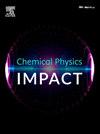Molecular insights into the structural, spectroscopic, chemical shift characteristics, and molecular docking analysis of the carbamate insecticide fenobucarb
IF 4.3
Q2 CHEMISTRY, PHYSICAL
引用次数: 0
Abstract
In this study, fenobucarb a carbamate pesticide has been analyzed for its structural, spectroscopic (FT-IR and FT-Raman), electronic (UV–Vis.), chemical shifts (NMR) and topological, and bioactivity using the theoretical DFT technique. In optimized geometry, the computed bond distance of N3-H29 is reduced compared to other bond distances. This reduction is attributed by electron-with drawing in the carbonyl group. Carbon atoms C8 and C14 are bonded to single-bonded and double-bonded oxygen atoms, resulting in increased resonance signals at 157.87 ppm and 159.19 ppm, respectively, attributed to the oxygen atoms deshielding effects. NBO analysis computed increased stabilizing energy at 34.05 kcal/mol by electron-donating from lone pair (LP) oxygen (O2) to the antibonding O1-C14. The topological analysis emphasizes the shielding and deshielding regions within the molecular structure of fenobucarb. Molecular docking analysis revealed that fenobucarb forms hydrogen bonds and hydrophobic interactions with the target protein, exhibiting a binding energy of -5.75 kcal/mol, confirming its antibacterial activity.

氨基甲酸酯类杀虫剂灭虫威的分子结构、光谱、化学位移特性和分子对接分析
本研究采用理论离散傅里叶变换(DFT)技术分析了氨基甲酸酯类杀虫剂灭虫威的结构、光谱(FT-IR和FT-Raman)、电子(UV-Vis)、化学位移(NMR)和拓扑结构以及生物活性。在优化的几何结构下,计算得到的N3-H29的键距比其他键距要小。这种还原是由于羰基上的电子吸引作用。碳原子C8和C14分别与单键和双键氧原子成键,在157.87 ppm和159.19 ppm时,由于氧原子的去屏蔽效应,共振信号分别增加。NBO分析计算出孤对氧(LP)给电子给反键O1-C14增加了34.05 kcal/mol的稳定能。拓扑分析强调了丁腈威分子结构中的屏蔽区和去屏蔽区。分子对接分析表明,杀虫威与靶蛋白形成氢键并发生疏水相互作用,结合能为-5.75 kcal/mol,证实了其抗菌活性。
本文章由计算机程序翻译,如有差异,请以英文原文为准。
求助全文
约1分钟内获得全文
求助全文
来源期刊

Chemical Physics Impact
Materials Science-Materials Science (miscellaneous)
CiteScore
2.60
自引率
0.00%
发文量
65
审稿时长
46 days
 求助内容:
求助内容: 应助结果提醒方式:
应助结果提醒方式:


